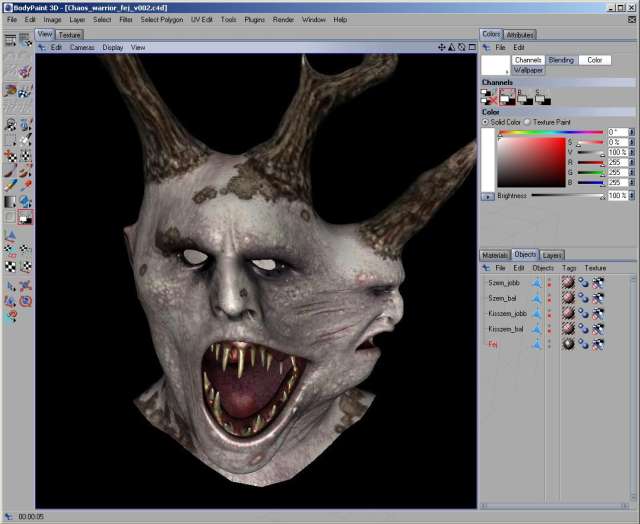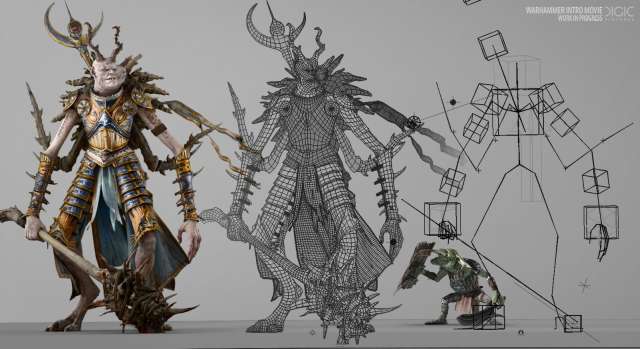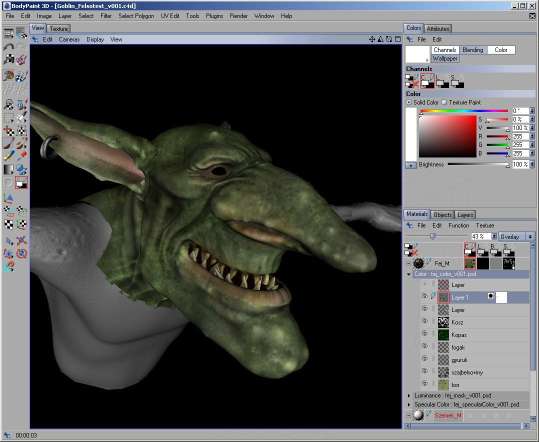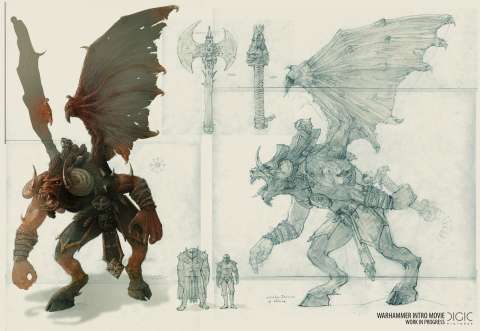Peter Fendrik and Digic Pictures Bring the Rendered Cinematics of Warhammer: Mark of Chaos to Life
|
|
ADVERTISEMENT |
When Namco and Games Workshop were looking to bring their soon to be released, Warhammer: Mark of Chaos PC RTS videogame to life for its fall 2006 debut, they came to Digic Pictures to take this epic saga from the storyboards and make the rendered cinematics a reality. Digic took this story, which pits the forces of good against those of evil, and crafted a storyline that brings the world of this new epic to life. Warhammer's world of fantasy is transformed into a 40 second long teaser trailer and a three and a half minute intro movie introducing this chronicled battle.

Still from the teaser cinematic for Namco's upcoming release, Warhammer: Mark of Chaos videogame
Art Director at Digic Pictures, Peter Fendrik was brought in to accomplish this goal. He was asked to work with his team of graphic artists to breathe life into the rendered cinematics that Mark of Chaos needed. Creating the stunning visuals was their objective, and they were able to skillfully craft not just a strong visual style, but a living world entrenched in the battle between good and chaos.
Namco came to Digic after seeing their work on earlier projects like Terminator 3: Rise of the Machines and a previous PC game, Armies of Exigo. This Hungarian based 3D animation and visual effects company is just part of the Cinergi Interactive business group owned by the Hungarian born Hollywood producer, Andrew G. Vajna.
Digic Pictures became one of the only visual effects producing groups in Hungary, to take on a significant role in the production of a significant Hollywood blockbuster film, with their work on the third installment of the Terminator series. This visual arts powerhouse helped solidify its role as a rising star in the industry when in 2003 it was recognized by SIGGRAPH for the company's high quality rendering work on the Armies of Exigo cinematics project.
Heading up this project for Digic's work on the rendered movies for Namco's Warhammer: Mark of Chaos, is Art Director Peter Fendrik. This is the second major project that Fendrik has participated in since joining the Digic Pictures team in the fall of 2005. After working as the head of the art department at a Hungarian advertising agency for nearly a decade, Fendrik decided to test himself and his animation skills by making the jump to the computer animation world of Digic Pictures.
Having graduated from the Hungarian University of Art and Design in 1995, as a graphic artist, Fendrik had focused his efforts on working with still images for illustrations. However, working in a still, unchanging world, proved to not fully satisfy his artistic desire. Wanting to see his creations move, and come to life, Fendrik decided to put some serious effort into developing and getting involved in the three dimensional world.

Screenshot from Digic Pictures development of the Chaos Champion of Tzeentch character
He believes that "Digic Pictures is probably the best team in Hungary to work with, [with] these goals in mind."
Inspired by classic artists like M.C. Escher and Albrecht Dürer, Fendrik starts every project with a clear concept in mind. Creating a concise image of what he wants to accomplish, first in his mind, allows him the ability to build and mold this initial idea into a graphic creation that has jumped from his imagination to reality. In the creative process, Fendrik warns that the artist should not allow the software and effects to take control of the project, or force them to accept a simple solution to problems that arise when taking the image from their mind and bringing it to life. Even if these issues are enough to create mind splitting headaches, this graphic artist knows that a project is not truly completed until if feels like it has come out exactly as he had imagined it.
Always having loved to draw and illustrate growing up, this artist looked forward to a future in his passion. However, according to Fendrik, in Hungary there is almost no demand for these types of artists. A "regular" job just did not appeal to him, not allowing him to become involved in anything serious with a deadline. Though he admits that he could never master the paintbrush, becoming interested in and developing his skills in 3D has made for a suitable substitute for painting.

Digic Pictures' development of Warhammer: Mark of Chaos Chaos Champion of Tzeentch character
A few years ago, while still working in the advertising industry, Fendrik got his first look at CINEMA 4D when he got a demo of the program. He would play around with the program after work, learning more about it and developing his graphic imaging skills as he learned.
Even though he has been working in 3D for years, incorporating BodyPaint into his artwork since the program first hit the market, Fendrik still finds it hard to believe that the ability to do this sort of work even exists.
"I can almost touch my creations, but certainly can walk around, rotate and manipulate them in any way I like. In 3D I can really exercise my aptitude for details," he explains.
Finding out later about creating the right setting, playing around with the lighting and being able to create an ideal overall atmosphere was just like the icing on the cake for him. Of course, being able to change his mind at some point in the project and not having to completely start from scratch, has always been a huge positive in working digitally. In the past, programs working in 2D painting could not reach the same dramatic results that Fendrik has found working in 3D.
Since Fendrik loves nature, somehow almost every piece of work that he creates resembles it to an extent. Realizing the ideas that he wants to make reality is the simple part for Peter, however, the process of taking these mental creations and making them real and three dimensional takes work. He starts out by first sketching these ideas on paper. Only when he is completely satisfied with the way that his idea has come out, does Fendrik move to make this image three dimensional.

Screenshot from Digic Pictures development of a Goblin character for the rendered cinematics
The rest has become routine; creating the model, applying texture to it, adding lighting effects and so on. He often adds a twist to the creative process, by interrupting the modeling process by working on texturing or vice versa. Fendrik likes to switch his process up in order to avoid creating a long and monotonous rendering process. More importantly though, this allows him to quickly find out and fix anything that does not seem to work, while the texture is still being applied.
Using the once more conventional 2D painting methods for applying textures to 3D models was always a struggle toward perfection for Fendrik. Making the jump to using MAXON's BodyPaint program has made this process a dream come true for him.
"Possibly, I would have never started seriously working in this field if this tool wasn't available," he adds.
In a nutshell, he finds that one of the best things about working in BodyPaint and CINEMA 4D, is that they are very user friendly programs, capable of handling a tedious workload. Before BodyPaint, Fendrik had been using Adobe Photoshop to create less complex textures. Since starting to render with BodyPaint, he has used almost nothing else.
The RayBrush technology, has become one of the most important features of the program, because it allows him to essentially see the final results as close as possible to what they will look like, while still painting. This allows Fendrik to paint on a perfectly lighted and rendered image in almost real time.

Digic's sketches for the Bloodthirster, Greater Daemon of Khorne character
This graphic artist uses C4D to do his modeling and rendering. BodyPaint is his choice when texturing, and he uses Photoshop in the final phases creating his amazing images, including touching them up in order to achieve perfection with every work.
In the past, there were short movies created to build the storyline in video games, like the one Digic has fashioned for the Warhammer project. The quality clips like those produced at Digic Pictures, have only really developed within the past few years. As the video game industry has evolved and games became bigger and better projects, more impressive work began to appear. This increase in the quality of the movies and games is a direct result of the advancements in computer technology and what it allows graphic artists to do.
As budgets grow, some games are becoming big enough to capture the budget of a small Hollywood movie. With increased budgets like these, very complex rendered movies can be produced for these games, the same kind of animated short movies that the graphic artists at Digic Pictures produce. Though these short films are not as long and quite as in-depth as a feature length 3D animated film, Digic still takes its job extremely seriously, trying to bring out the best cinematically and artistically produced work they can.
This is why Namco came to Digic to bring their new game, Warhammer: Mark of Chaos, to life with the rendered movies they were to create. Though the creatures and characters were created in a collaboration with Games Workshop and Namco, Fendrik and Digic were trusted to create the story and spectacles on their own.
Once the team was able to generate the story that they wanted to bring to life, and script it out, Fendrik sat down with his team of graphic artists to discuss the visuals and characters that are going to be in the film. After the basic models are created, they are digitally sculpted as the three dimensional models are finalized. These models are then textured as they digitally become the characters that will appear in the Warhammer teaser and intro that make the game's story come alive.
After the character rigs that are going to be used are set up, the animation and rendering processes take over, which are rather unique at Digic since it is set up to handle and generate very complex elements. Compositing is the final step in the whole process.
Their rather unique process often causes them to create and develop many of their own tools. But in creating the fantastic worlds and characters that they use in their Mark of Chaos work, Fendrik enlisted the help of BodyPaint because he feels that it is the best painting program on the market. It has proved itself to be reliable enough to handle their workload as well as be compatible with other programs, like Maya, that Digic Pictures uses in their creations.
The characters that Digic, Namco and Games Workshop have created are the core to the epic clash of thousands of characters as they battle on screen in great and intricate detail. As the armies that players command, move from battle to battle, the fantastically rendered films that Digic has created, build this heroic story into the epic war that it is.
Ian Cassuto is a freelance writer residing in Southern California.
Discuss this article in the forums
Date this article was posted to GameDev.net: 3/29/2006
(Note that this date does not necessarily correspond to the date the article was written)
See Also:
Featured Articles
© 1999-2011 Gamedev.net. All rights reserved. Terms of Use Privacy Policy
Comments? Questions? Feedback? Click here!